Partnership helps Alaskans build better homes
By Amy Simpson and Jeff Fay, Cooperative Extension Service
November 2006
![]()
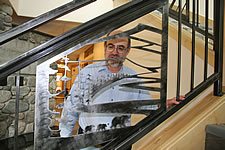
Extension Energy and Housing Specialist Rich
Seifert admires the artistic detailing of a stair railing within the Cold
Climate Housing Research Center building.
![]()
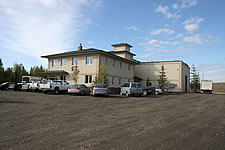
The Cold Climate Building
and Infrastructure Research and Testing Facility was designed by members
of the Cold Climate Housing Research Center.
![]()

UAF Chancellor Steve Jones
addresses guests during the grand opening and dedication of the Cold
Climate Housing Research Center building Sept. 23, 2006.
![]()
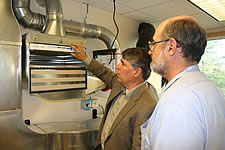
Mike
Musick describes the sophisticated ventilation system of the CCHRC
building to Rich Seifert.
![]()
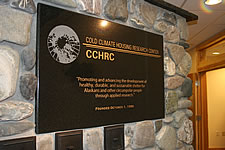
The CCHRC mission statement is attached to
a wall of the 12,000-pound wood-fired masonry heater on the main floor
of the building.
![]()
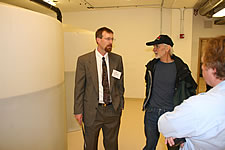
UAF Civil and Environmental Engineering
Department Chair Dan White discusses the gray water and rainwater
reservoir tanks and system in the basement of the CCHRC building
with UAF Provost Paul Reichardt and Michael Lilly of GW Scientific.
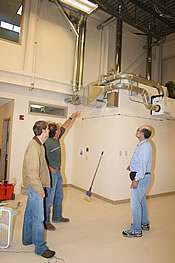
Garrison Collette, left, Jack Hébert, center, and Rich Seifert tour one of the laboratory spaces in the CCHRC.
Known as the "energy guy" on the Fairbanks campus, Rich Seifert is passionate about teaching people how to save energy and build efficient, healthy homes.
As the UAF Cooperative Extension Service energy and housing specialist, he has taught classes on cold climate building techniques across Alaska for more than 16 years. With energy costs steadily rising, especially in rural Alaska communities, Seifert feels it’s imperative to provide research-based information to help make Alaska’s energy use more sustainable over the long term. While the information Seifert delivers is solid, much of the research was done in Canada and Scandinavia.
"We’ve had to rely on a considerable amount of information from other circumpolar countries of the world because there hasn’t been a central point for broad-based Alaska housing research--until now," Seifert said. "With the arrival of the Cold Climate Housing Research Center on the Fairbanks campus, all that is going to change."
The CCHRC is an industry-based, nonprofit corporation created to facilitate the development, use and testing of energy-efficient, durable, healthy and cost-effective building technologies for Alaska and the world’s cold climate regions. Jack Hébert, CCHRC president and CEO, sees the collaborative research partnership between Extension and CCHRC as a win-win situation.
"CCHRC has always looked at Extension as a resource for education and outreach, and we wanted to help them develop their building science curriculum," says Hébert, who also sees the potential for an exchange of educational materials and collaborative publications.
Seifert recently hired CES Energy and Housing Program Assistant Garrison Collette to serve as a liaison to CCHRC. Collette’s office is located in the recently completed Cold Climate Housing Research Center Research Testing Facility on the edge of the Fairbanks campus, which was designed and built by CCHRC members and is a foundational part of its strategic and business plans.
"A liaison’s duty is to stay in touch with what is going on at the CCHRC and be able to provide the most accurate and timely information available to CES," Collette said. "CCHRC needs a dedicated outreach person with an extensive, established network to get its findings out to the general public, and a CES-associated liaison is perfect for this role."
Extension has a well-established system for disseminating research-based information to Alaska homeowners, builders and industry representatives through its publications, workshops, seminars and distance-delivered outreach. Through this clientele Extension will be able to help its partners at CCHRC direct their research efforts.
With an outreach office within CCHRC, the CES Energy and Housing Program is poised to further extend the practical applications of research on cold climate technologies and products for all Alaskans, including the development of strategies for greater energy security and economically sustainable homes throughout the state.
Additionally, Extension will have access to the builders’ resource library within the facility, which will be electronically tied in to all circumpolar university libraries that deal with housing issues.
"It’s a great resource for CES and for us," Hébert said.
New program addresses rural energy challenges
In a rapidly changing arena where traditional and contemporary cultures and economies meet, developing and maintaining sustainable communities is a challenge--especially building energy-efficient homes and reducing costs of energy use in rural Alaska.
In the late 1980s, an Energy Extension Service was created in the model of the Cooperative Extension Service to help distribute energy information to the public. Funded by the U.S. Department of Energy, Alaska ultimately ended up relying on monies from an oil litigation settlement. During the Reagan era the funding was cut and the program disappeared.
The Rural Energy Extension Program is an emergent effort in recognition of the fact that rural Alaska is in an energy crisis because of vastly increasing fuel costs. Seifert believes that much of the rest of Alaska will probably follow suit as the fuel prices rise in the future.
The reasons for this are manifold, Seifert says, but the Rural Energy Extension Program within Extension essentially reinvents the Energy Extension Service--but this time in conjunction with CCHRC.
The primary purpose of the project is to connect the resources of UAF and CCHRC with the energy-related needs of individuals and communities in rural Alaska. Seifert hopes funding for the project will support the employment of two energy Extension agents--one located at CCHRC and one at the Extension district office in Bethel.
"The goal is to provide energy and housing research-focused information to rural Alaskans to help them in this time of crisis," Seifert said. "CCHRC will enhance our programming by making the connection between Extension and the research results so close and so unimpeded."
Energy and housing science isn’t the only link Extension has with CCHRC. To provide program support for and development and delivery of education and research programs in sustainable agriculture and community development, Extension will also house a sustainable communities instructor at CCHRC.
The person in this position will focus on helping sustain communities through research that addresses the needs of rural Alaskans. The research will focus on diversification of crop systems, sustainable vegetable and fruit production systems, and alternative energy and building technologies, and will include researchers at Extension, CCHRC, the UAF School of Natural Resources and Agricultural Sciences (name changed to Institute of Agriculture, Natural Resources and Extension) and rural communities.
Connecting the circumpolar community
The CCHRC was conceived of and developed by members of the Alaska State Home Builders Association. Over the five years since its inception, CCHRC has developed strong private and public sector partners across Alaska, the nation and the world.
Through these partnerships with public, private and government organizations dealing with housing and building issues, knowledge gained from the research conducted at CCHRC will be widely disseminated throughout the circumpolar community. CCHRC has developed strong private and public sector partners across Alaska, the nation and the world. Extension is not the only university-associated entity with a connection to CCHRC. Staff from the Institute of Northern Engineering will occupy one of the labs and conduct research on housing-related subjects.
One example of how information may be shared is through the National Association of Home Builders, which has more than 210,000 member companies nationwide.
"They will take our research data and turn it into popular publications that can be distributed nationwide or worldwide," Hébert said.
Although the builders’ resource library is a good start in converting research into circumpolar publications, Hébert also sees the need to begin a dialogue within the circumpolar community to address issues of common interest in the North. As part of the International Polar Year, CCHRC is planning a circumpolar housing conference to be held in Alaska in fall 2007.
"In all kinds of disciplines, whether it’s anthropology, economics or building science, Alaska is full of some really amazing people who aren’t afraid to experiment and think outside of the box," Hébert said. "They are out there."
In the coming months and years Hébert and Seifert aim to find these talented Alaskans and get them talking to each other through the auspices of the CCHRC.
For more information please contact:
- Rich Seifert, Extension energy and housing specialist, ffrds@uaf.edu or (907) 474-7201
- Garrison Collette, Extension energy and housing program associate and cold climate energy and research liaison, gs.collette@uaf.edu or (907) 474-2402
- Jack Hébert, Cold Climate Housing Research Center president and CEO, jack@cchrc.org or (907) 457-3454
Other useful links:
- Cold Climate and Housing Research Center
- Cooperative Extension Service
- CES Alaska Energy and Housing
All photos by Jeff Fay, Extension Communications, unless otherwise noted.



